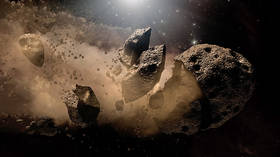Close encounter: HUGE asteroid sped past Earth at 22,000mph

While much of the world was sleeping soundly and the remainder were going about their daily lives, an asteroid roughly half the size of the Statue of Liberty shot past the Earth at 22,000mph (35,406kph).
Asteroid 2019 SR8 is considered a ‘near-Earth object’ or NEO by NASA, and whizzed past us at a distance of over 3 million miles around 03:45 BST Wednesday. SR8 measures between 65 and 144 feet in diameter (20 and 44 meters).
For comparison, Rome's Colosseum is 157 feet (48 meters) tall and the leaning tower of Pisa measures some 183 feet (56 meters) tall. The flyby fun doesn’t stop today though.
Also on rt.com 111-foot asteroid screeching towards Earth at over 22,000 miles per hourOn Friday, five asteroids will make a close Earth approach, the largest of which rivals London's Big Ben at 320 feet (95 meters) in diameter. While the vast majority of NEOs pose little to no threat to the Earth, our planet has suffered greatly from asteroid impacts in the past, so what exactly is the threat posed by different sized asteroids?
Size matters
A house-sized meteorite exploding in the Earth's atmosphere could produce a force greater than that of the nuclear bomb dropped on Hiroshima in 1945. A space rock with a diameter of roughly the same height as a 22-story building, would level an area on Earth the size of central Paris.
Half a mile wide is where asteroids start having truly global consequences. One such space rock would destroy an area the size of the US state of Virginia, triggering massive earthquakes felt thousands of miles away, while simultaneously throwing up a dust cloud that would block out the sun.
Beyond this size, we have the asteroid that is believed to have wiped out the dinosaurs. This category is populated by London-sized asteroids (and above) that would trigger extinction-level events, and even hit hard enough to slow down the Earth's rotation and make the day last almost half a second longer.
Also on rt.com Four asteroids on COLLISION course with EarthLike this story? Share it with a friend!












